So Dominaria got partially leaked. This is old news to pretty much everyone, but this is the first time it meaningfully happened while I have been a content creator in this capacity. When New Phyrexia leaked in 2011, it was this weird time where I was excited to see the entire set so early, but the ripples didn’t really dawn on me as to how it affected content creators. I can personally say that this time has shifted my writing schedule a little bit, because I saw cards that I would want to include in articles I was preparing for and suddenly felt that an extra week or two before sending those piece to publication wasn’t going to change anything. But I was also a little sad that it appeared that I might not get something like the Kumena, Tyrant of Orazca reveal, where the whole package sold me instantly on upending my writing to cover that card only a few days later.
Miraculously, the current Magic community has been much more gung ho about these leaks and turned it into a cause for good by actively asking to get the chance to preview cards with the—at the time of writing—unseen art and flavor text. I don’t feel like the initiative would have been taken by the community in the past and I don’t know that Wizards would have even considered this change of audience interaction as a possibility before. Partially I think it is the love for Dominaria that inspired people to not let this leak ruin all the fun, but I also think Wizards is learning that much the community would be happy to preview cards, even down to the commons and uncommons normally held off for the mass dump on the last Friday of previews.
Today, I would like to break down a card that I was instantly excited by and lobbied for getting as a preview, but understandably didn’t get the scoop ahead of time. We’re taking a trip back to lunch room Magic and exploring the reprinted Thorn Elemental, best shown off in a Thriss, Nantuko Primus deck. Since I’ve tread this ground recently with my outline of Silvos, Rogue Elemental, I will not be holding myself to an era of Magic, the entire history of the game is available. Let’s get started.
Thriss, Nantuko Primus
I was destined to be a Commander player from the very beginning of my Magic tenure. Upon finding the game one of the most compelling parts was the lore, exemplified by this “Legend” creature type that came with special rules. After finding out about Gatherer roughly a year into playing I would spend all my time searching through every legendary creature in existence—luckily this was nine months before Kamigawa block—trying to distill whatever information I could about each character. The novels I had access to at the time were covering the Odyssey and Onslaught blocks, with Moons of Mirrodin just seeing print, and I was constantly grabbing names from the novels and typing them into Gatherer to get a clearer picture of the characters I was reading about. We had dial-up at the time, so this easily filled my afternoons.
Thriss was part of the Nantuko, a race of peaceful insect people that lived within Otaria’s Krosan Forest as its protectors. If memory serves, he helps to shift Kamahl from a red-aligned character to green-aligned. As a card, the steep mana cost for Thriss pays off in the long run as they become capable of casting a super sized Giant Growth every turn, making Thriss a potent general that gets overlooked for not have an explicit purpose. This deck is looking to highlight Thorn Elemental and its mechanical kin to deliver large chunks of damage, hopefully activating our general a few times a turn for maximum output. Mono green is not a bad color to be restricted to, but I will admit that we may need to dip into sinister means to insure a victory.
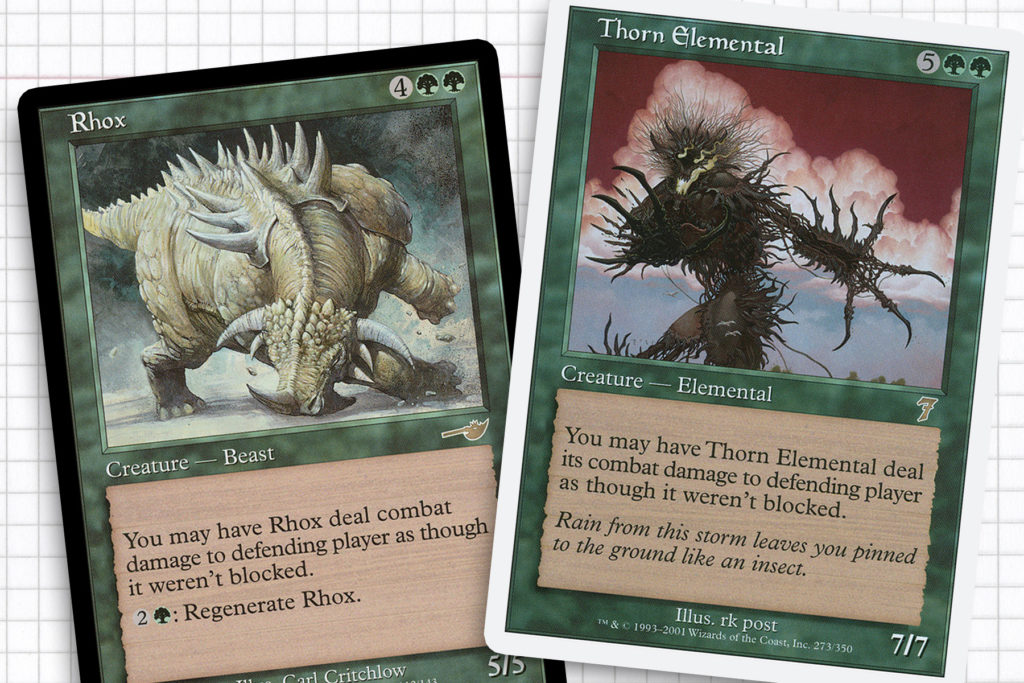
Super Trample
As I’ve talked about in previous installments, my formative years with Magic were shaped by iconic creatures, but not necessarily the ones Wizards had been trying to push. Yes, Serra Angel was a threat, as was Sengir Vampire—depending on who you talked to—but the real creatures being talked about in hushed tones were Avatar of Woe, Mageta the Lion, and Thorn Elemental. At the time creatures like Lone Wolf and Pride of Lions existed to offer up smaller versions of the Elemental’s ability, but nothing could really stand up to a 7/7. As far as I can tell, the ability premiered in Portal Second Age and was designed to be a green form of evasion or “super trample” as it was so called by Erik Tierman (who gave me the idea for this deck skeleton). I think it is interesting design space, but I can understand why it’s never been something we see constantly.
The ability has only seen print on ten creatures including Deathcoil Wurm, Gurzigost, Rhox, Spinebiter, Tornado Elemental, Wolf Pack, and most recently Siege Behemoth—a creature that grants the ability to all other creatures attacking along with it. On second thought, maybe “siege” is a better nickname. This niche combat ability pairs really well with Thriss’ ability to pump creatures, since you know the damage is always going to make it through. If it weren’t for the double digits of mana needed to pull it off, I am a little surprised this interaction was never used by anyone I knew. As printed, none of these creatures are horrible for their mana costs and even as a one time dedicated source of damage, I believe all of them can make our list. Lastly, if we’re looking to not telegraph our alpha strike with some of our utility creatures a turn early, Predatory Focus is a nice sorcery version of this effect.
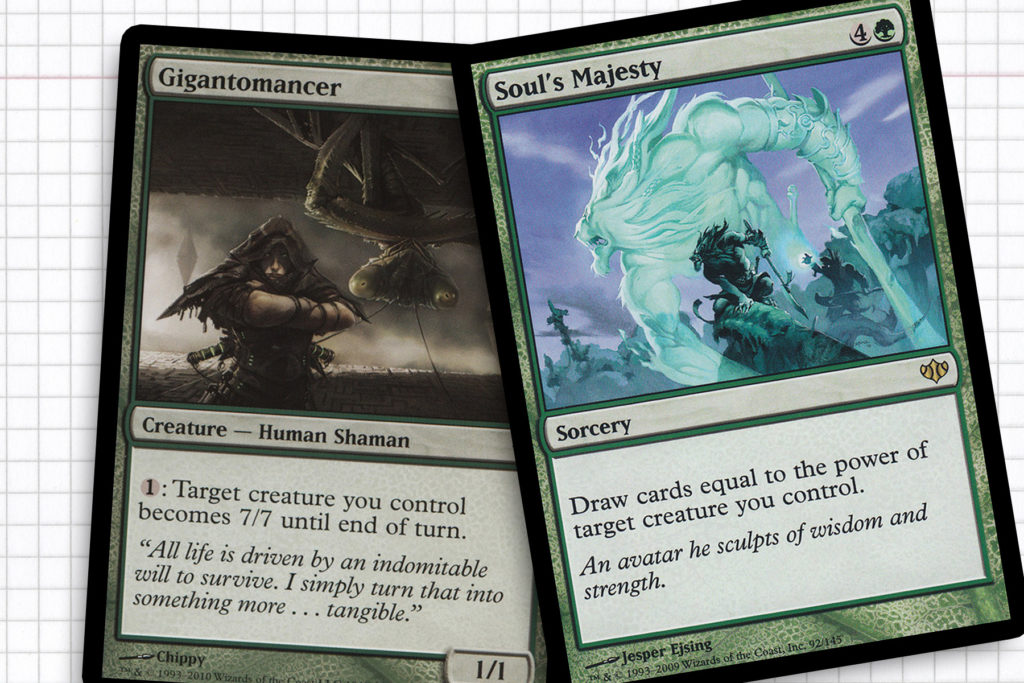
Live Draw
Thorn Elemental hasn’t existed in Magic since Eighth Edition and in that time a lot of the green color pie has shifted, especially how green accumulates card advantage. Whereas we used to have to fix our draws with Howling Mine or Abundance in mono green, now we can leverage the size and/or number of creatures. If we’re using Thriss to make one or two of our creatures considerably big, we can quickly draw a handful of cards with Rishkar’s Expertise, Soul’s Majesty, or Shamanic Revelation. For even more card draw, we’ll put our creature into the red zone and leverage “super trample” so that Hunter’s Insight and Hunter’s Prowess get us a lot of bang for our buck.
To empower the aforementioned cards, I would recommend Aspect of the Hydra, Gaea’s Embrace, Mythic Proportions, Gigantomancer, and Gigantiform as ways to bulk up the size of our creatures and make our card draw spells even more potent. The modern green color pie really feeds solid card draw paired with the gold standard of creature buffing.
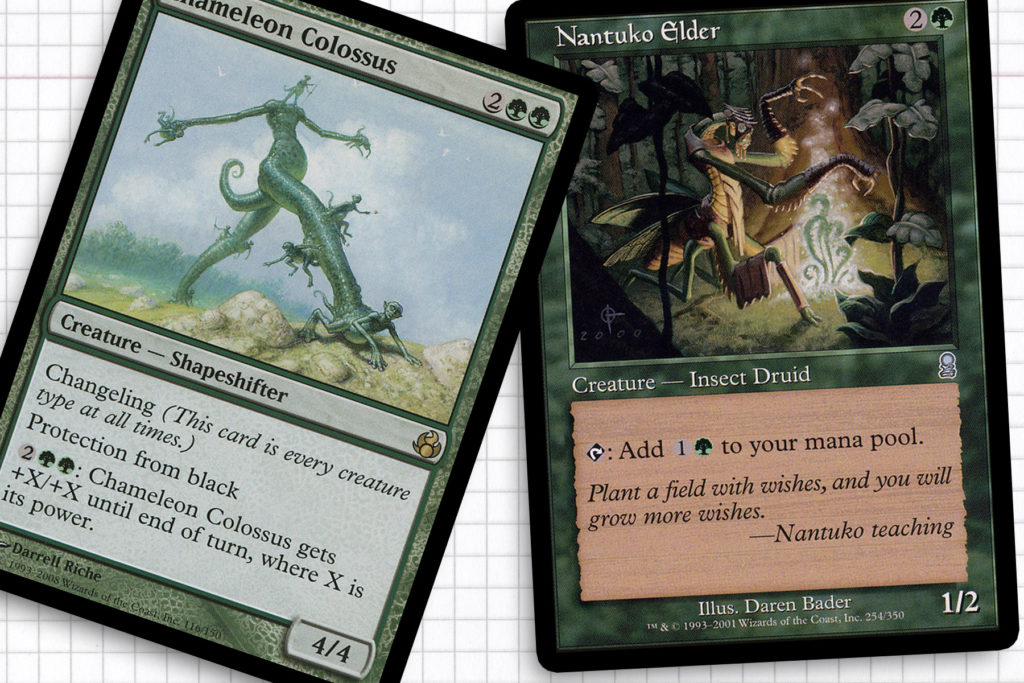
Nantuko Hussle
Nantuko and Cephalid, what a strange era to start Magic in hindsight. It wouldn’t be until Mark Rosewater’s podcast Drive to Work—an entire decade into playing the game—that I would understand what was going on with these strange creature types that seemingly popped up in Odyssey and Onslaught barely to be referenced again. At the time, I suppose I had no reason to really question why squid or mantis people were running around, that was just Magic. The thought going into Odyssey was that Magic should highlight other creatures types outside of the typical elves, goblins and merfolk. This resulted in the block utilizing creature types that pushed the Creative Team to make new sapient races from unique roots.
I don’t believe these insect druids need to be a large theme of our deck, but several will help us play a consistent game of Magic. Nantuko Elder is a hidden gem that I am a little surprised doesn’t see play. If your first turn is playing an Elvish Mystic, you can play the Elder on the second turn, untapping with at least six available mana on turn three with normal land drops. And then there is Nantuko Mentor, which allows any of our creatures to do a Chameleon Colossus impression, filling the role of a mini-Thriss at a minimum and a supercharged one with a very high glass ceiling.
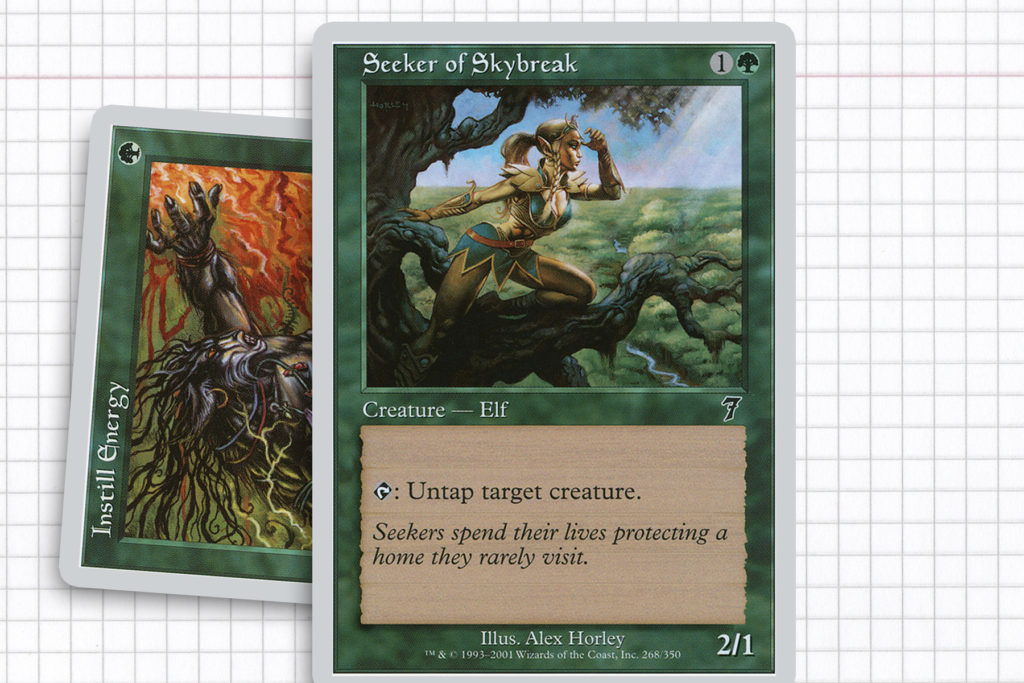
Untapping Potential
With Thriss as our general we’re going to want to maximize the amount of super Giant Growths we can pump out each turn. Obviously there are only so many Illusionist’s Bracers and Rings of Brighthearth in the history of Magic, so we’re going to need to look for effects that untap Thriss and not just copy his ability.
Back in the day we would have just slapped Instill Energy onto Thriss and called it a day; at the time Malachite Talisman wasn’t a known quantity around the lunch table and Vitalize was only really used in Elf decks as a green High Tide. The next good pieces of tech are Seeker of Skybreak and Magewright’s Stone—both require little set-up but make our creatures menacing. This might be one of those decks where Seedborn Muse doesn’t really combo with the deck in a desired way, but since it’s Seedborn Muse, I assume there is an interaction I am overlooking.
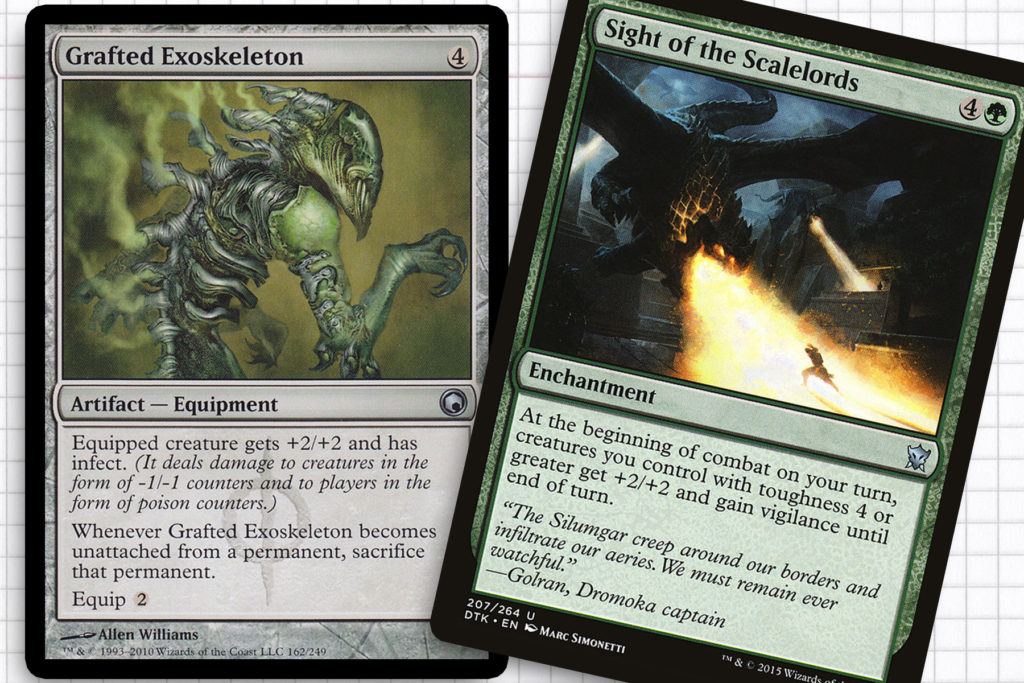
Compleat Victory
When it finally comes time to try to win the game, Grafted Exoskeleton and Triumph of the Hordes are blunt avenues to victory that will do little to help you make friends. Poison is a very touchy subject in Commander; it is a viable strategy that is very parasitic as a mechanic, because you’re attacking a life total completely separate from the rest of the table and your efforts might not matter if you fail. The worst part in a metagame sense is that it can end games out of nowhere, possibly leaving one player out in the early parts of the game. This happened with my Dakkon Blackblade shadow deck, booting a player a full 45 minutes before the end of the game.
Here poison plays a similar role, because we have “super trample” at our disposal, we can attacking knowing full well if we’re likely to take an opponent out of the game. But if we want to play on the same axis as the rest of the table while still utilizing our spotlighted suite of creatures, then Overrun, Overwhelming Stampede, Sight of the Scalelord, Beastmaster Ascension, and Pathbreaker Ibex are all inclusions making our army into battlecruisers in the long-term and playing along the same axis as the rest of the table.
Reprints can be interesting. While few are excited to see Evolving Wilds, reprints like Thorn Elemental can not only dredge up feelings veteran players like myself might have, but also clue in new players to the cards existence. In most Commander decks the Elemental likely won’t see play, but I might say that I have personally overlooked this card’s power for too long. In a deck designed to enhance “super trample” or “siege” the effect can be very potent, to the point where an Archetype of Endurance could do a lot of good to keep our creatures safe and allow for large swings of damage. In terms of decks I have outlined on this column, I think this one has a lot of potential and hopefully room to grow. I would love to hear people’s thoughts on this, feedback is the life blood of content creation. But until next time, thanks everyone. Have a great week.

